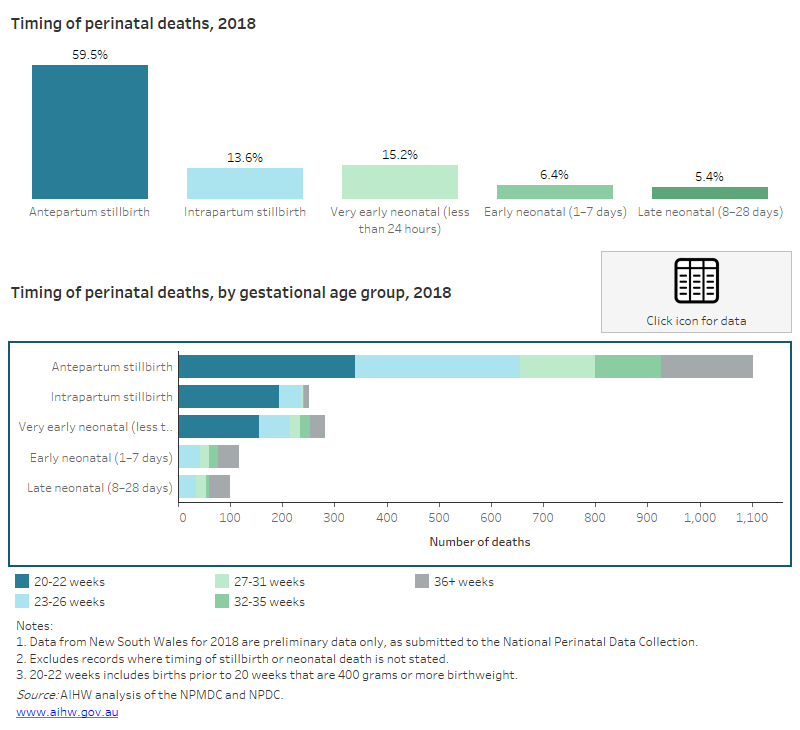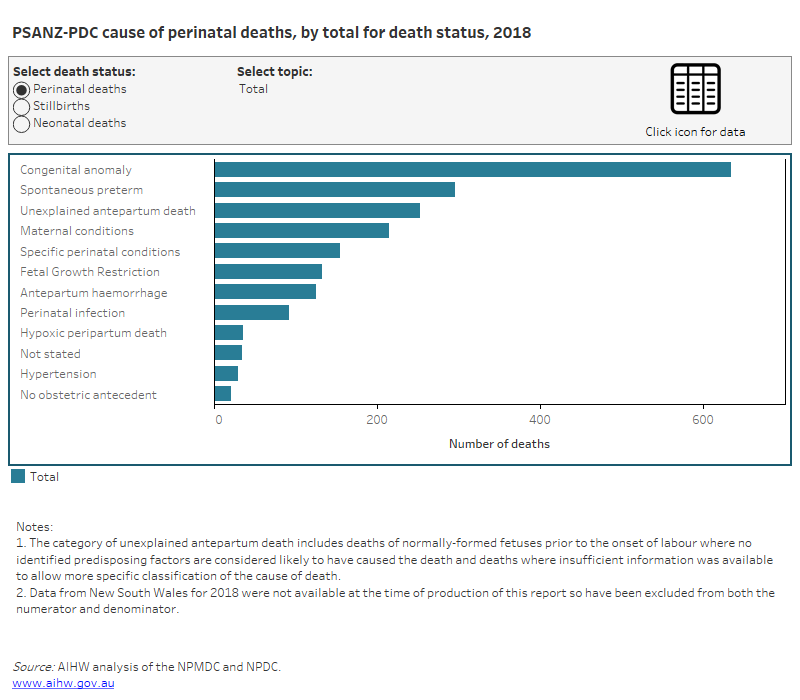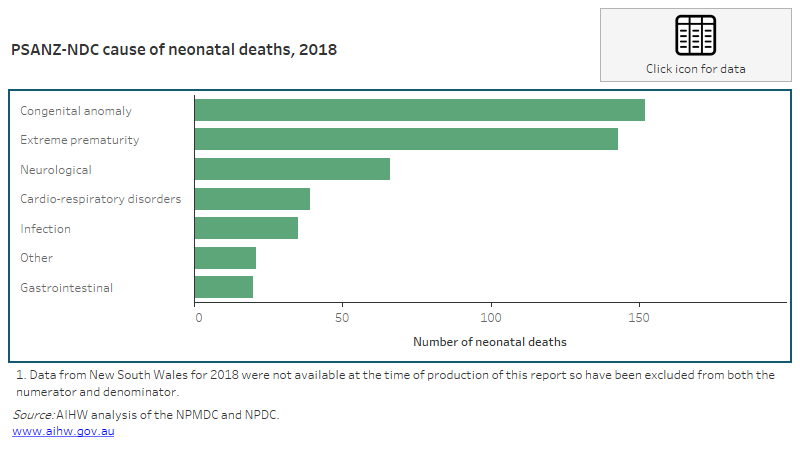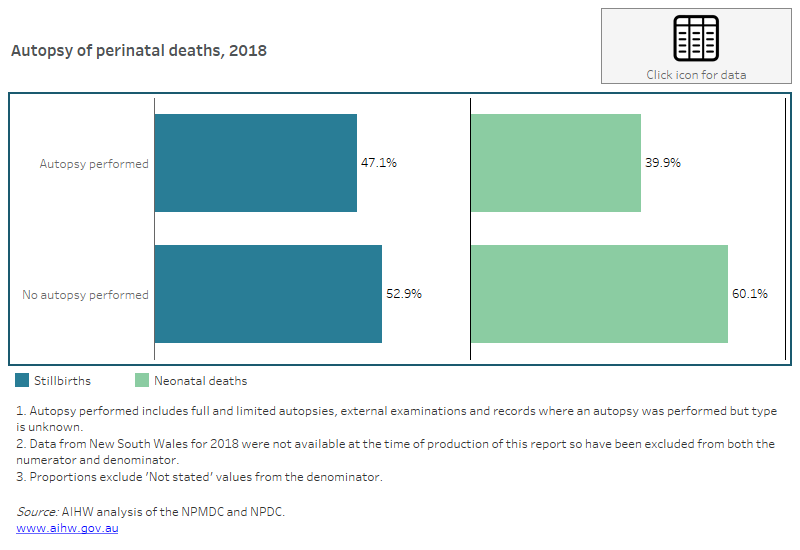Timing, causes and investigation of perinatal deaths
Timing of perinatal deaths
In 2018, where the timing of perinatal deaths was stated:
- Nearly three in five (59.5%) perinatal deaths and the majority (81.4%) of stillbirths occurred before the onset of labour (antepartum death)
- Nearly three in five (56.4%) neonatal deaths occurred within the first 24 hours following birth and were more common with decreasing gestational age
- Early neonatal deaths (1–7 days) and late neonatal deaths (8–28 days) were more common among babies born from 36 weeks gestation.
Definitions of timing of perinatal death can be found in the Technical notes—Definitions used in reporting.
Intrapartum stillbirths (those occurring during labour and birth) and neonatal deaths within the first 24 hours after birth are often considered together as, in many cases, the process leading to the death is a continuum that may lead to death before or after the birth occurs.
Chart title: Timing of perinatal deaths, 2018
The vertical bar chart at the top of this data visualisation shows the timing of perinatal deaths. The majority, 59.5%, were antepartum stillbirths. This was followed by deaths in the very early neonatal period (less than 24 hours), and intrapartum stillbirths, 15.2% and 13.6% respectively. Early and late neonatal deaths accounted for 6.4% and 5.4% of deaths respectively.
The stacked horizontal bar chart at the bottom of this data visualisation shows the timing of perinatal deaths by gestational age group. Antepartum stillbirth was the most common time of death for all gestational age groups, with more than half of antepartum stillbirths being babies born at less than 27 weeks’ gestation. Most intrapartum stillbirths and very early neonatal deaths were for babies born at 20-22 weeks’ gestation, while most early and late neonatal deaths were babies born at 36 weeks’ gestation or more.

Causes of perinatal deaths
Causes of perinatal deaths are classified according to the Perinatal Society of Australia and New Zealand (PSANZ) Perinatal Mortality Classification System, version 2.2, as part of each state or territory’s perinatal mortality review process.
The PSANZ Perinatal Mortality Classification System incorporates a Perinatal Death Classification (PSANZ-PDC) and an additional Neonatal Death Classification (PSANZ-NDC).
The PSANZ-PDC system classifies all perinatal deaths (stillbirths and neonatal deaths) by the single most important factor which led to the chain of events which resulted in the death (refer to Technical notes—Definitions used in reporting for cause of death classifications).
In 2018:
The most commonly classified causes for all perinatal deaths were:
- Congenital anomaly (31.4%)
- Spontaneous preterm birth (14.6%)
- Unexplained antepartum death (12.5%).
The most commonly classified causes of stillbirths were:
- Congenital anomaly (31.7%)
- Unexplained antepartum death (16.6%)
- Maternal conditions (13.3%).
The most commonly classified causes of neonatal deaths were:
- Spontaneous preterm birth (32.7%)
- Congenital anomaly (30.3%)
- Specific perinatal conditions (6.2%).
Chart title: PSANZ PDC causes of perinatal deaths, by various characteristics, 2018
The horizontal bar charts in this data visualisation show the different PSANZ Perinatal Death Classification causes of death by a range of different maternal and baby characteristics. In the total view, it shows that congenital anomaly was the most commonly classified cause of perinatal death, followed by spontaneous preterm birth and unexplained antepartum death.
The difference in causes by gestational age group shows that congenital anomaly remained the most commonly classified cause of death for all gestational age groups, from 23.5% of deaths for babies born at 36 weeks or more to 35.4% of deaths for babies born at 20-22 weeks. This was followed by spontaneous preterm birth for babies born at 20-22 and 23-26 weeks (22.3% and 19.6% respectively), and by unexplained antepartum death for babies born at 27-31 weeks, 32-35 weeks and 36 weeks or more (16.7%, 21.3% and 22.8% respectively).
The difference in causes by timing of death shows that congenital anomaly remained the most commonly classified cause of death for antepartum stillbirths (26.6%), intrapartum stillbirths (44.0%), as well as early neonatal deaths (28% of deaths). This was followed by spontaneous preterm birth for intrapartum stillbirth and early neonatal death (23.8% and 24.6% respectively), and by unexplained antepartum death for antepartum stillbirths (22.8%). The most common cause of death for very early and late neonatal deaths was spontaneous preterm birth (39.0% and 25.0%, respectively), followed by congenital anomaly (35.5% and 19.0%, respectively).
The difference in causes by maternal age group shows that congenital anomaly was the most commonly classified cause of death for all age groups except mothers aged under 20, from 22.8% of deaths for mothers aged 20-24 to 36.2% of deaths for mothers aged 35-39. This was followed by maternal conditions for mothers aged 20-24 (19.0%), by spontaneous preterm birth for mothers aged 25-39, 30-34 and 35-39 (16.9%, 13.6% and 13.9% respectively), and by unexplained antepartum death for mothers aged 40 or over (12.0%). For mother aged under 20, the most common cause of death was maternal conditions (35.2%), followed by congenital anomaly (16.5%).
The difference in causes by plurality shows that congenital anomaly was the most commonly classified cause of death for all single pregnancies, 32.8%, followed by spontaneous preterm birth and unexplained antepartum death (13.4% and 12.7% respectively). The most commonly classified cause of death for multiple pregnancies, or multiple pregnancies, was spontaneous preterm birth, accounting for 27.2% of deaths, followed by specific perinatal conditions and congenital anomaly (26.6% and 16.3% respectively).
The difference in causes by birthweight percentile shows that congenital anomaly remained the most commonly classified cause of death for all groups. It accounted for 33.1% of deaths for babies born small for gestational age, 30.3% of deaths for babies born appropriate for gestational age, and 45.2% of babies born large for gestational age. This was followed by Fetal Growth Restriction for babies born small for gestational age (22.4%), by spontaneous preterm birth for babies born appropriate for gestational age (19.0%), and by specific perinatal conditions for babies born large for gestational age (13.9%).
The underlying data for this data visualization are also available in the Excel spreadsheet located on the Data page.

In 2018, congenital anomaly was the most commonly classified cause of perinatal death, and this remained true across almost all deaths, regardless of maternal or gestational age, plurality, baby’s birthweight percentile or the timing of death. The only exceptions to this were for:
- Late gestation stillbirths. Unexplained antepartum death was the most commonly classified cause of death for stillbirths occurring at 32-35 and 36+ weeks’ gestation (27.9% and 35.9%, respectively).
- Early gestation neonatal deaths. Spontaneous preterm birth was the most commonly classified cause for neonatal deaths occurring at 20-22 and 23-26 weeks’ gestation (47.8% and 55.9%, respectively).
- Babies born to mothers aged under 20. Maternal conditions were the most commonly classified cause of perinatal death for babies born to mothers aged under 20 (35.2%). Maternal conditions refers to deaths where a medical condition (e.g. diabetes) or a surgical condition (e.g. appendicitis) or an injury in the mother (including complications or treatment of that condition) is the cause.
- Multiple births. Spontaneous preterm birth was the most commonly classified cause for multiples (27.2%), followed by specific perinatal conditions, such as cord entanglement (26.6%).
- Very early (less than 24 hours) and late neonatal deaths (8–28 days). The most commonly classified cause of very early and late neonatal deaths was spontaneous preterm birth (39.0% and 25.0% respectively).
- Neonatal deaths in babies considered appropriate for gestational age (AGA). Spontaneous preterm birth was the main classified cause of neonatal deaths for babies considered appropriate birthweight for their gestational age (39.3%)
Causes of neonatal deaths
The PSANZ-NDC is an additional classification system applied only to neonatal deaths to identify the single most significant condition present in the neonatal period that caused the baby's death.
In 2018, the most commonly classified conditions causing neonatal deaths were:
- Congenital anomaly (30.3%)
- Extreme prematurity (28.5%)
- Neurological conditions (13.2%).
Chart title: PSANZ NDC cause of neonatal deaths, 2018
The horizontal bar chart in this data visualisation shows that congenital anomaly was the most commonly classified condition causing neonatal death, followed by extreme prematurity and neurological conditions. Together, they accounted for 72% of all neonatal causes of death. The remaining deaths were caused by cardio-respiratory disorders (7.8%), infection (7.0%), other conditions (4.2%) and gastrointestinal conditions (4.0%).

Investigation following perinatal death
Autopsy
The National Perinatal Mortality Data Collection collects data on whether or not an autopsy was performed and, where applicable, the type of autopsy performed (a full autopsy, limited autopsy or external examination).
For the purposes of this report, deaths where any of these autopsy types have been performed will collectively be treated as deaths where an ‘autopsy’ has been performed.
The purpose of an autopsy is to accurately identify the cause(s) of death. Autopsy results contribute to clinical audit and assist with identification of factors contributing to the death. Perinatal autopsy examinations require written consent from the parent(s) following informed discussion.
In 2018, there were 2,789 perinatal deaths, 1,956 of which (1,475 stillbirths and 481 neonatal deaths) had a stated autopsy status. Of deaths where autopsy status was stated, there were:
- 886 (45.3%) perinatal deaths that had an autopsy performed
- 694 (47.1%) stillbirths and 192 (39.9%) neonatal deaths that had an autopsy performed.
Chart title: Autopsy of perinatal deaths, 2018
The horizontal bar charts show that more than half of all perinatal deaths reported not having an autopsy performed. A higher proportion of stillbirths reported having an autopsy performed than neonatal deaths, 47.1% vs 39.9% respectively.



